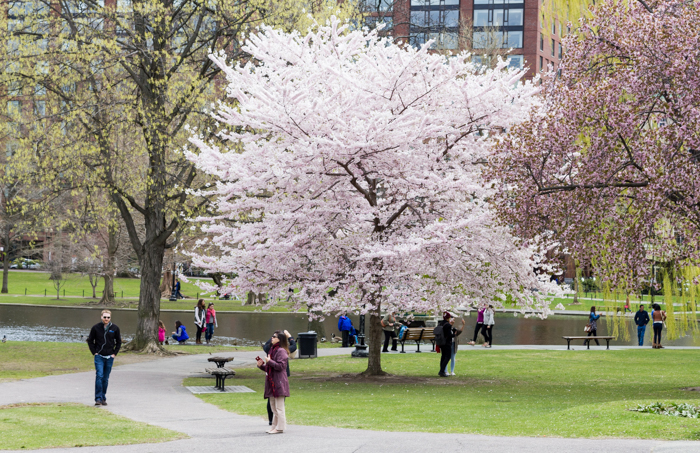
The surest sign of spring is the cloud of gorgeous pink cherry blossoms throughout the Public Garden as well as in areas of the Boston Common. Flowering cherry trees are among the most beautiful and widely planted of mid-sized ornamental trees, usually as tall as they are wide. Though native to Central China where wild trees can grow to sixty or more feet — twice the size in cultivation — it is in Japanese cultivation that the species takes on significance. The Japanese have developed many cherry tree varieties over the centuries; it is rooted deep in their culture. Hanami is the Japanese traditional custom of enjoying the transient beauty of flowers, specifically cherry blossom viewing started in the Heian period (794-1185) and continued today. Cherry blossoms are often associated with the beauty and fragility of human life due to their intense beauty and short survival span.
Between the Common and the Garden, there are 27 specimens of different cultivars each with their own characteristics. Of the 27, the vast majority are Kwanzan or Kanzan Cherry (Prunus serrulata). The showiest of all the cherry trees, its flowers are “double pink” with an amazing profusion of deep pink double flowers with a longer blooming period than most other cherries. Unlike all other cherry trees, Kwanzan trees begin to grow leaves while the flowers are still in bloom. As the blooms begin to fade and close up, they leave behind the green leaves which turns to brilliantly colored orange, yellow or copper foliage in the fall.
Both the Kwanzan and the Yoshino Cherry (Prunus Yeodensis) were made famous as part of one of America’s most glorious floral displays at the annual Cherry Blossom Festival in Washington, D.C. These trees were part of a 1912 gift to the people of the United States from the people of Japan made by the Mayor of Tokyo, as a symbol of friendship between the two countries. There are three Yoshino Cherry trees in the Public Garden collection. Two of these are cuttings grown from the famous Washington, D.C. cherry trees, and were planted in 2012 to mark the centennial of the original gift from Japan. The Yoshino is celebrated for its vibrant display of white-pink, almond-scented blossoms coming out all at once along its bare branches in early spring and then quickly falling, leaving a carpet of very pale pink. The Yoshino cherry blossoms usually come out several weeks before the Kwanzans.
Another popular cherry tree in the parks is the Sargent Cherry (Prunus Sargentii). In spring, clusters of lovely, pink to deep pink single flowers appear before the leaves unfold, and the blooms last longer than other cherries. This cultivar is named after Charles Sprague Sargent, the American plant collector, and first Director of the Arnold Arboretum who discovered the species in the mountains of northern Japan in 1892.
The Garden’s collection is home to three Autumn Flowering Higan Cherry trees (Prunus subhirtella). These trees fully flower in the spring, and often bloom again with lovely pink buds and white flowers off and on during a warm autumn season. In addition to the sporadic fall bloom, there is a lovely foliage show of bronze, yellow, gold or deep-red leaves. A Weeping Higan Cherry (Prunus subhirtella Pendula) rounds out the collection. There is nothing quite like the Weeping Higan Cherry in full bloom in the spring. The light pink, almost white, flowers cover the branches before the leaves emerge, giving the appearance that fresh snow has fallen on the tree.
Each year in the Common and the Garden, we experience the eternally springtime sight of seeing cherry trees laden with their ethereal pink and white flowers, a promise of awakening and celebration of life.
How can we ever lose interest in life? Spring has come again, and cherry trees bloom in the mountains.
Japanese poet Ryokan Taigu

